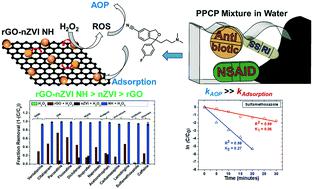当前位置:
X-MOL 学术
›
Environ. Sci.: Water Res. Technol.
›
论文详情
Our official English website, www.x-mol.net, welcomes your
feedback! (Note: you will need to create a separate account there.)
Adsorption and advanced oxidation of diverse pharmaceuticals and personal care products (PPCPs) from water using highly efficient rGO–nZVI nanohybrids
Environmental Science: Water Research & Technology ( IF 3.5 ) Pub Date : 2020-06-24 , DOI: 10.1039/d0ew00140f Arvid Masud 1, 2, 3, 4, 5 , Nita G. Chavez Soria 3, 4, 5, 6, 7 , Diana S. Aga 3, 4, 5, 6, 7 , Nirupam Aich 1, 2, 3, 4, 5
Environmental Science: Water Research & Technology ( IF 3.5 ) Pub Date : 2020-06-24 , DOI: 10.1039/d0ew00140f Arvid Masud 1, 2, 3, 4, 5 , Nita G. Chavez Soria 3, 4, 5, 6, 7 , Diana S. Aga 3, 4, 5, 6, 7 , Nirupam Aich 1, 2, 3, 4, 5
Affiliation

|
Engineered nanomaterials, like graphene with tunable adsorption sites and nanoscale zero-valent iron (nZVI) with unique redox chemistry, offer great prospects for removing pharmaceutical and personal care products (PPCPs) through adsorption and catalytic advanced oxidation processes (AOPs) in comparison to bulk materials. Although PPCPs are found as a complex mixture in wastewater and in the environment, most studies regarding nano-enabled PPCP removal reported results with only one PPCP at a time and typically at high initial concentrations. In this study, we utilized reduced graphene oxide (rGO) as a support for nZVI to synthesize rGO–nZVI nanohybrids (NHs) and used rGO–nZVI NHs for the removal of a complex mixture of 12 diverse PPCPs that includes antibiotic, anti-inflammatory, anti-seizure, and antidepressant pharmaceuticals, which are recalcitrant in the environment. We also tested the removal of PPCPs at their individual environmentally relevant concentrations at the ppb level. The rGO–nZVI NH was synergistically utilized as both an adsorbent and a heterogeneous Fenton catalyst (for AOPs) in the presence of H2O2 to remove ∼95–99% of environmentally relevant concentrations (200 ppb) of PPCPs within 10 minutes. Even in the absence of H2O2, the hybridization resulted in better adsorptive properties (14–72% more removal) of the rGO–nZVI NHs compared to the parent nanomaterials (rGO or nZVI) for various PPCPs in the mixture, removing ∼82–99% of PPCPs, at the end of 30 minutes, with comparatively slower kinetics (∼3–5.5 times) than in the presence of H2O2. Hydrophobic PPCPs were removed faster and more PPCPs were removed by both adsorption and AOPs. The potential of utilizing rGO–nZVI NHs in drinking/wastewater treatment systems, or even in point-of-use systems where necessary, was substantiated by the enhanced and fast PPCP removal capacity of nanohybrids.
中文翻译:

使用高效的rGO–nZVI纳米杂化物从水中吸附和深度氧化多种药物和个人护理产品(PPCP)
工程纳米材料,例如具有可调吸附位点的石墨烯和具有独特氧化还原化学性质的纳米级零价铁(nZVI),与散装相比,通过吸附和催化高级氧化工艺(AOP)去除药物和个人护理产品(PPCP)的前景广阔。材料。尽管发现PPCP是废水和环境中的复杂混合物,但是大多数有关纳米级PPCP去除的研究报告一次仅使用一种PPCP的结果,并且通常以较高的初始浓度进行。在这项研究中,我们利用还原型氧化石墨烯(rGO)作为nZVI的载体来合成rGO–nZVI纳米杂合物(NHs),并使用rGO–nZVI NHs去除了12种不同PPCP的复杂混合物,其中包括抗生素,抗炎药,抗癫痫药和抗抑郁药,在环境中是顽强的。我们还测试了ppb浓度下与环境相关的PPCP的去除量。在存在H的情况下,rGO–nZVI NH协同用作吸附剂和非均相Fenton催化剂(用于AOP)2 O 2在10分钟内除去约95–99%的环境相关浓度的PPCP(200 ppb)。甚至在没有H 2 O 2的情况下,与母体纳米材料(rGO或nZVI)相比,杂交也能使rGO-nZVI NHs具有更好的吸附性能(去除率提高14-72%),从而去除了〜在30分钟结束时,有82–99%的PPCP比在H 2 O 2存在的情况下具有相对更慢的动力学(〜3–5.5倍)。疏水性PPCP的去除速度更快,并且吸附和AOP均可去除更多的PPCP。在饮用水/废水处理系统中,甚至在必要时在使用点系统中使用rGO-nZVI NHs的潜力,已被纳米杂化物增强且快速的PPCP去除能力所证实。
更新日期:2020-07-31
中文翻译:

使用高效的rGO–nZVI纳米杂化物从水中吸附和深度氧化多种药物和个人护理产品(PPCP)
工程纳米材料,例如具有可调吸附位点的石墨烯和具有独特氧化还原化学性质的纳米级零价铁(nZVI),与散装相比,通过吸附和催化高级氧化工艺(AOP)去除药物和个人护理产品(PPCP)的前景广阔。材料。尽管发现PPCP是废水和环境中的复杂混合物,但是大多数有关纳米级PPCP去除的研究报告一次仅使用一种PPCP的结果,并且通常以较高的初始浓度进行。在这项研究中,我们利用还原型氧化石墨烯(rGO)作为nZVI的载体来合成rGO–nZVI纳米杂合物(NHs),并使用rGO–nZVI NHs去除了12种不同PPCP的复杂混合物,其中包括抗生素,抗炎药,抗癫痫药和抗抑郁药,在环境中是顽强的。我们还测试了ppb浓度下与环境相关的PPCP的去除量。在存在H的情况下,rGO–nZVI NH协同用作吸附剂和非均相Fenton催化剂(用于AOP)2 O 2在10分钟内除去约95–99%的环境相关浓度的PPCP(200 ppb)。甚至在没有H 2 O 2的情况下,与母体纳米材料(rGO或nZVI)相比,杂交也能使rGO-nZVI NHs具有更好的吸附性能(去除率提高14-72%),从而去除了〜在30分钟结束时,有82–99%的PPCP比在H 2 O 2存在的情况下具有相对更慢的动力学(〜3–5.5倍)。疏水性PPCP的去除速度更快,并且吸附和AOP均可去除更多的PPCP。在饮用水/废水处理系统中,甚至在必要时在使用点系统中使用rGO-nZVI NHs的潜力,已被纳米杂化物增强且快速的PPCP去除能力所证实。











































 京公网安备 11010802027423号
京公网安备 11010802027423号